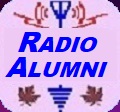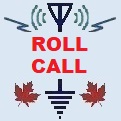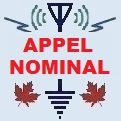|
|
RADIOALUMNI.CA |
|
|
CANADIAN EPICS IN RADIOCOMMUNICATION ALUMNI WHO LIVED THE ADVENTURE OF RADIO WIRELESS TELEGRAPHISTS - SPARKS - RADIO PIONEERS RADIO OPERATORS - RADIO TECHNICIANS RADIO TECHNOLOGISTS - RADIO ENGINEERS RADIO INSPECTORS - SPECTRUM MANAGERS |
|
ÉPOPÉES CANADIENNES EN RADIOCOMMUNICATION LES ANCIENS QUI ONT VÉCU L'AVENTURE DE LA RADIO TÉLÉGRAPHISTES SANS FIL - PIONNIERS DE LA RADIO OPÉRATEURS RADIO - TECHNICIENS RADIO TECHNOLOGUES RADIO - INGÉNIEURS RADIO INSPECTEURS RADIO - GESTIONNAIRES DU SPECTRE |
A Technologist's Experience From personnal correspondance - Laval Desbiens
1968 marked the first induction of technologists into the Department of Transport (DOT). When the recruiting team came to my college I was asked if I would prefer to be a DOT technician or a radio inspector. Perhaps because I was one of the few who did not have to be told what a radio inspector did, I was hired as an RI. Half of the RI group immediately attended the Air Services Training School (ASTS) in Ottawa, for three months basic training. The other half, myself included, started working immediately. I was assigned to 'XE' (Saskatoon).
Up until technologists were recruited, Radio Inspectors generally came from the ranks of former WW-II servicemen, radio operators, and DOT technicians. While most of us were welcomed, a few of us had a bit of a rough time at first; perhaps some of the old hands felt that we had somehow jumped the queue. But apart from one little incident, the guys in Saskatoon quickly warmed to me and things went smoothly. Working with a good team was one of many lucky breaks that I would receive during my career.
In those days the nature of our work was entirely different than it is today. Techniques and our raison d’être evolved, but more on this later. Back then, on the authorization side we strove to individually license nearly every station; a little over a decade earlier even broadcast receivers were required to be licensed. On the enforcement side, we tried to inspect every station every year, even hams and mobiles. While some of the inspections, such as aircraft, were rather cursory, and oriented somewhat towards finding unlicensed stations; others, such as land-mobile service bases and mobiles were somewhat service oriented. We often set up a production line with our antiquated equipment (Gertch FM3 frequency standard, RS deviation meter and Wattmeter), running fleets through for frequency, deviation and power checks. Most of the fleet operators loved this as it saved on preventive maintenance, even though we discovered the odd unlicensed station in the process. And, from our point of view, what with the drifty nature of the old equipment, we felt that were keeping the airwaves clean.
This process was made easier by several orders of magnitude when we received our first “test set”, a Cushman. In those days virtually every reported case of interference was investigated and usually remedied. We got a “green stamp” for each unit of work done. Since XE was a large territory, we often went on the road for a week, sometimes even two, coming back to the office with more than enough “green stamps” to meet our quota for the month. There was little local or regional analysis of the overall health of the spectrum. All reports went to HQ via RHQ—the paper flow was enormous.
Individual performance was predominantly measured by the production of work units, which we called green stamps. We also had an annual evaluation, but it was a single legal-sized page with tick boxes. Most bosses started you at a medium level and if you did reasonable work moved you up a tick or two each year.
Many of us were a different breed of cat than the earlier civil servants, and the differences were sometimes striking. In XE, we were co-located with many other government departments in the Federal Building. Civil servants in those days usually wore quasi-uniforms, mostly navy blazers or charcoal suits, with white shirts and ties. I, on the other hand, often wore a sports jacket with leather elbow patches, sometimes a turtleneck, and even a peace symbol from time to time. I did not know it at the time, but a few people in other departments had complained to my boss about the way I dressed. My boss, Heddle Sinclair, had been around “forever”, since the days when the service was part of the Marine and Fisheries Department, and he must have been considered by those who did not know him well as staid, perhaps even a bit of a dinosaur. Imagine my surprise when he turned up one day in a sports jacket and turtle neck and said, "Let's go down to the canteen for coffee." No further complaints were received!
With three months of experience under our belts, my half of the group then went to Ottawa for its initial 3-month ASTS training, and the other half went into the field. We alternated twice, for a total of 6-months training. The ASTS staff had a tiger by the tail with my class. Not only had we just completed several years of formal education in electronics engineering technology, but we had enough work experience to be 'dangerous'. We challenged everything, sometimes not very tactfully. I’ll never forget one session when our instructor was struggling mightily to lecture us how FM stereo works. One of the guys kept interrupting him and correcting him until he said, “I suppose you can do it better?” Student became teacher and proceeded to do just that. In all fairness, though, the training we got at ASTS was generally very good, as most of it covered the operational aspects of communication systems that were only taught to us as theory at school. Over the years, ASTS was scaled back, probably due to budget restraint and perhaps due to the regions flexing their muscles as they grew more dominant. I always thought it was a pity. Not only did ASTS ensure that the basics were all covered, but it provided a venue for RIs from all over Canada to interact.
Howard Hitchcock, one of the old hands at XE said to me shortly after I joined, "If you want to get ahead be sure to apply for every promotion that comes along; and take laterals if they will give you varied work experience”. Following his advice paid off and I credit him for my comparatively rapid rise through the ranks.
In late 1970 I was transferred to Winnipeg, where I worked for Irwin Williams, as one of three authorization officers. Nearly all authorization was centralized. The field offices sent in letters of authorization (LOAs), which we checked over and sent to HQ, who in turn produced the licences. I considered the process of checking over the hundreds of LOAs to be “busy work”, as I had already begun to question our work procedures to some degree. As a test, I began stamping a few of the LOAs in each batch sent to HQ with a stamp I had inherited from a previous incumbent. The stamp read, “Peanuts and Garbage Department”. Nobody ever commented on this.
Much of the technical analysis and all but the simplest authorizations were done at RHQ, I did UHF, VHF and Microwave. While the applications originated in the field, most of the field offices made frequency recommendations only. We did not have word processing machines; all the LOAs were individually written out by the authorization officers and typed by our secretaries. Moreover, each letter had to be individually approved by our boss, and many were “bounced”. Here was an area that I could improve. I went through scores of previously approved LOAs and extracted each unique paragraph. From these I compiled a booklet containing standard paragraphs for every possible aspect of the authorisation. Thereafter producing an LOA simply consisted of giving my secretary a small note saying Paragraphs A, C, E, L, M and Q, and the frequency, power and emission.
When I was in Winnipeg, bilingualism in the Service became a really big thing. I immediately applied for language training, only to be told that training was first being given to more senior and older employees. Eventually I was transferred to Trois Rivières for two years. Eric Shea, then in charge of central region (the RSRR), had somehow pushed my application through; this was another important break in my career.
When I arrived in Trois Rivières nobody knew what to do with me, as the bicultural exchange program at that time was only a name with no substance. For a while, I took French language training at Berlitz for a few hours every day, and before too long I could converse easily with the teachers in their formal French. But I found that I could not deal with clients, especially in the rural areas, as they spoke colloquial French. Claude, the OIC, agreed to let me work out the remainder of my two years entirely in French. I also signed up to teach radio at an Air Cadet Squadron. This was truly total immersion and it worked. Even today, although I rarely have the opportunity to speak French, I can still converse in the language with good fluency. I was also thankful to Claude who often gave me the more technical jobs and research work to do, moreover, he was keen on improving work methods and involved me in that work.
After the two years in Quebec Region I was moved to Winnipeg doing special projects for Irwin Williams. Irwin had me write the original Central Region Technical Manual (CRTM), which attempted to document work flows, techniques, and to modernize and standardise. As the spectrum was becoming more crowded it was evident that we needed new approaches to authorizing stations and the CRTM was the first foray into the area. I wish I could claim that it was entirely my doing, but while the contents and recommendations mostly were, the inspiration was Irwin’s and much of the input came from colleagues in the region.
The OIC in XE was not well and everyone knew that whoever won the 2IC job recently posted would be the defacto District Manager. I won it and nearly everyone appealed; it may have been some sort of civil service record. Apart from one individual, there was no malice, just a reaction to someone so young having jumped the queue as it were. Fortunately for me regional management stood behind their choice and the appellants were unsuccessful.
As acting DM I reorganized and changed nearly everything in Saskatoon, and was quite proud of the team. One of the major innovations was to document the root cause of interference cases, not just identify the technical mechanism. For example, the mechanism for a complaint might have been receiver intermodulation, but the cause might have been an overpowered base station or one that was moved without authorisation. Unfortunately, when the position was posted for competition, Keith Macmillan, who was already a DM in another office, requested a transfer to Saskatoon. While Keith was a really nice guy, our styles and views on the way things should be done clashed; so I started to look for another position.
Real Valiquette, the RSRR in Atlantic Region, needed a Superintendent of Enforcement, and wanted someone to implement changes. He selected me, and I must have driven him mad at times with both the quantity and magnitude of the changes. My ideas today would be considered normal or even passée; but back then they were somewhat radical and were not at first appreciated by some of the district Managers. But it all worked out and before too long things were going well.
While I was in Atlantic Region, Ken Hepburn, the Assistant Deputy Minister (ADM) conceived the Spectrum Management Task Force and seconded me to head it up. Ken needed a fresh look at what we were doing and how we were doing it, as he was under pressure from Treasury Board to justify our programs. I thought that a lot of what we were doing could be done much more efficiently, and had a history of implementing change; we were a good match. This task force, an HQ/Regional group, was responsible for major changes in the methods of managing the spectrum. We modelled the spectrum and our processes, and questioned everything. Probably the most controversial, yet successful recommendation was using industrial quality control techniques as a model for inspections. We moved from inspecting as many stations as one could each year, to inspecting a minimum number of stations in defined populations using a sampling algorithm. Some of the saved resources were used to diagnose trends, sort out specific problems thereby discovered, and to deal with the source of the problems rather than the individual ones. Although procedures evolved, the work we did in the task force remained the foundation of spectrum management until well after I left the department.
After about five years in Atlantic Region, Vic Decloux, then Director of Operations in HQ, hired me as the manager of his frequency division (DOS-F). Shortly after, I won the position of manager of the policy and procedure division (DOS-P), which suited me much better. As DOS-P, my main job was to research and implement change, something that my now I was quite dedicated to. Bob Jones was by then DGRR and after a few failed bids, selected me as Director of Operations (DOS), the best job I had in the department. Those were the halcyon days of spectrum management. We tried to be more efficient and to better serve the public. New management committees sprang up and the role of the regions became more prominent. It was a great time to work in Spectrum Management. At one point, the Auditor General even named Spectrum Management as one of a few “performing organizations” in the government.
The work in HQ was very broad in scope. In addition to my role as DOS, Bob gave me a leadership role in WARC-92 preparation and negotiations, as principal spokesperson for regulatory matters. When Spectrocan needed someone to market Canadian spectrum management systems and techniques around the world and do spectrum management presentations around the world, I was seconded. These assignments gave me a taste for international travel.
In 1993, Motorola recruiters lured me to Singapore as Director of Government Relations for a number of countries in SE Asia. The work for Motorola was very interesting and rewarding. Much of it was oriented towards long-term benefits and as such was often altruistic. Our small team earned a name for itself among the regulators of the region as being a trusted source of information and advice. Two of us were former telecom regulators, and as principal regulatory spokesman at WARC-92 for Canada, my reputation often preceded me. In Taiwan the Chairman of the telecom authority began calling me Doctor Nunas. When I pointed out that I did not have a doctorate, he quipped that in Taiwan I did.
After working for Motorola for eight years I was again head-hunted, this time by Enron as Asia/Pacific Director of Government Affairs. Enron was a terrific company to work for. They were extremely innovative. However, only 6-months later Enron went bankrupt in a spectacular fashion.
When Enron went under, we were living on our 48-foot motor yacht at Raffles Marina in Singapore. The world economic situation was in tatters and the telecom industry was in a downward spiral, with a number of bankruptcies. So, after reviewing our resources and concluding that we could just manage, Louise-Ann and I decided to retire and spend our time exploring the world aboard the boat. We left Singapore in December 2002 and headed out to sea.
Thus far, we have been to Thailand, Malaysia, Indonesia, Helen Reef (Palau), Papua New Guinea, The Solomon Islands, Vanuatu, New Caledonia, New Zealand. We are currently enjoying Australia. We are living our retirement dream, largely made possible by deciding all those years ago to become a Radio Inspector.
Maurice Nunas February 2007
You can read more of Maurice's current activities on his web site http://www.nunas.com
|
|||||||||||||||
|
Links - Liens --- |
|||||||||||||||




